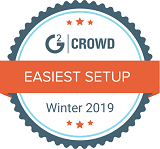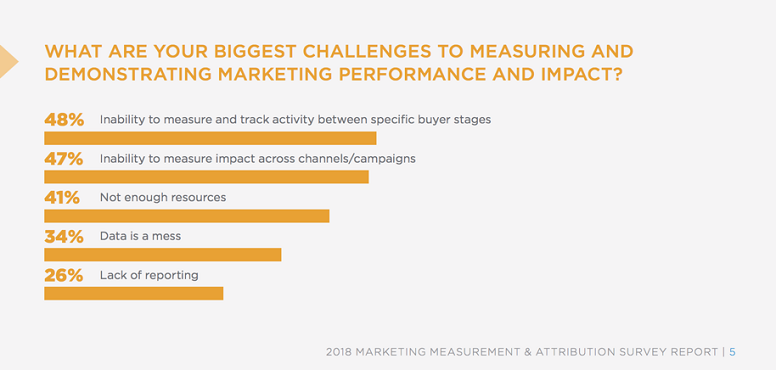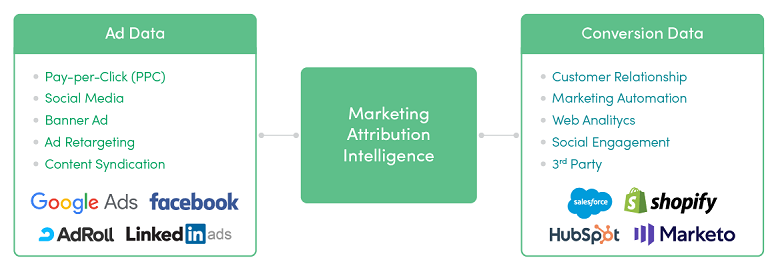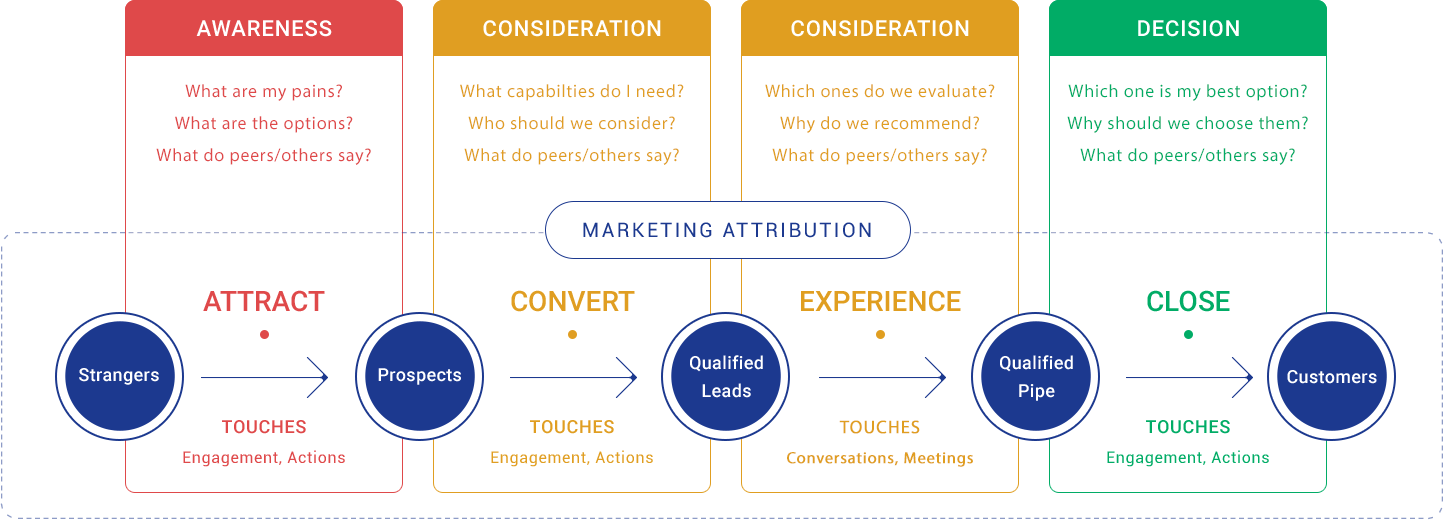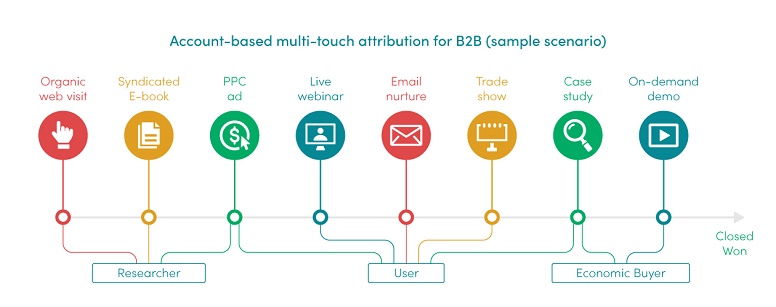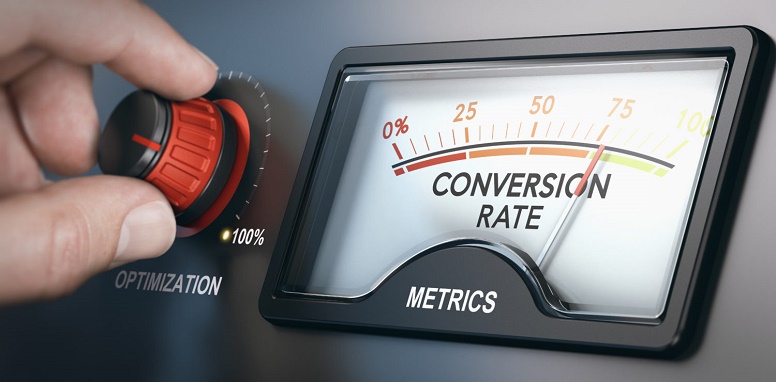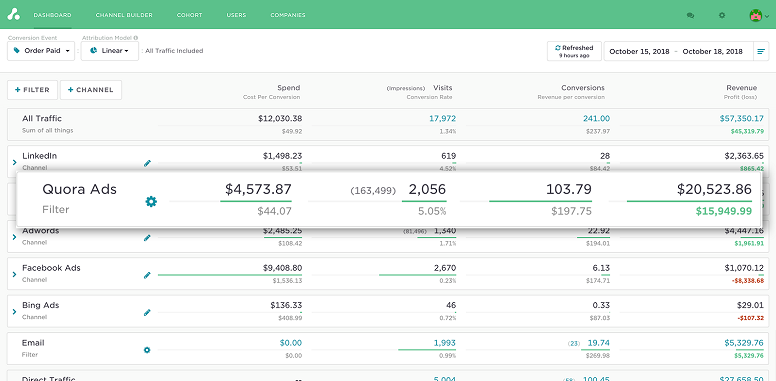“Which marketing channels should we put more money into? Reduce or stop spending?”
If you’ve ever asked these questions (or are still asking them), multi-touch attribution is your best bet to getting the right answers; it provides you with meticulous details of how buyers are engaging with your business and which marketing touches are driving purchase journeys. Plus, it shows everyone in your organization how much revenue you are bringing to the table, which puts you in good standing with your investors and builds credibility in budgeting with your peers.
While 82% of CMOs report that their goals are aligned to revenue targets (Forrester Research), B2B marketers are struggling to quickly connect the dots along a lengthy and complex B2B purchase process to make decisions that optimize revenue. According to DemandGen, 58% of B2B companies said their current ability to analyze marketing performance “needs improvement” or worse and 48% of B2B companies say their biggest challenge is the “inability to track activity between specific buyer stages.”
To close this burgeoning gap, many marketers are stitching together various technologies, data and spreadsheets to attribute marketing spend to revenue. However, this creates a data and management nightmare, and exacerbates your ability to continuously optimize your marketing investments to revenue.
WARNING: Unlike B2C, the B2B buyer’s journey is much longer and more complex, requiring the right multi-touch attribution system to capture and correctly attribute marketing touches to revenue. So if you are seriously considering instrumenting your marketing attribution to revenue outcomes, here are 6 best practices to ensure you’re on the path to accurately attributing spend and optimizing programs.
1. Capture all ad and conversion data
When it comes to attribution insight to do their jobs, most senior B2B marketers and their teams feel they are in a constant state of “data chaos,” suffocating under a combination of web, channel and CRM data that have been stitched together with Excel to give them the information they need to do their jobs. And how actionable, timely, and trusted is the end result?
To get an accurate and timely view of how buyers are interacting with your touchpoints, customer acquisition cost and lifetime value, you need to integrate your ad and conversion data into a multi-touch attribution system of record.
This allows you to accurately allocate revenue and cost back to all your marketing touches and channels that contributed to a closed sale. Without a multi-touch attribution system of record, your team is plagued with messy reports and spreadsheet sprawl, wasting time on non-value activities. To eliminate this attribution data chaos, senior marketers should look to three ‘must-have’ capabilities:
- Automatically capture all your ad and conversion sources using pre-integrated connectors to most or all of your internal and 3rd party sources, making it much easier and less costly to connect and maintain.
- Instantly collect buyer interactions outside of ad and conversion sources using tracking technologies such as UTM parameters, click redirects and other unique identifiers.
- Seamlessly access your marketing attribution connections and overall system using only a web browser (think true, not fake SaaS), enabling simple and quick set up and configuration to your needs.
By building your B2B multi-touch attribution system to these standards, you’ll have the foundation or “plumbing” in place that frees you from “data jail” to focus your energy on optimizing marketing spend to revenue.
2. Connect every touch across your buyer’s journey
Rather than trying to make sense from fragmented lists of marketing touches, best practice B2B multi-touch attribution automatically connects all your touches to your buyer’s journey. This means every touch that achieved its intended outcome is connected to the buyer throughout their entire journey and is assigned a revenue credit and cost, resulting in a significantly higher degree of attribution precision and giving marketers the trusted insight they need to optimize their budgets to revenue.
To illustrate the power of following your buyer’s journey, let’s consider a scenario for a technology buyer for ZZZ bank who is looking for business intelligence tools.
Awareness
In the buyer’s effort to understand ZZZ’s challenges and explore solutions, he begins by googling the web and researching various sources. One of your blogs shows up in his search results and he clicks on it and learns new insights on tackling his company’s problems – he also checks out your banking solution and company web pages. A week later he digs further into an independent tech community site he discovered for business intelligence and sees one of your ads pop up for an e-book, fills out the form and downloads it. That same week he continues researching on the web and one of your paid search ads pops up offering an educational video on business intelligence for banking.
Consideration
Feeling he has a good handle on ZZZ’s business intelligence pains and different solution options, the buyer begins to crystallize the capabilities they need to solve their challenges and the vendors they should consider. Impressed with your e-book and blog, he registers and attends one of your live webinars. Another week later he receives and clicks on one of your emails (that he consented to when he downloaded your e-book) featuring a new blog on business intelligence for banking and checks it out. A month later he attends a banking technology conference and drops by your booth and speaks with a product specialist to discuss his needs; he also watches a demo of your business intelligence product.
Decision
At this stage in the buyer’s journey, he has narrowed down ZZZ’s short list of vendors to further evaluate and recommend. He recalls the great experience he had at your booth and check’s out your website again to read the case studies of other banks that have gone through a similar business intelligence journey and are successfully using your tools. Later in the week the buyer is favoring your company and registers to watch your on-demand demo. At this point, your sales rep reaches out and schedules a live personalized demo for the following week. Impressed with the live demo, the buyer signs on for a paid proof of value and, upon completion of it, validates their business case. Though the buyer continues checking out your website, he moves ahead with pricing and a purchase contract for your business intelligence tools.
In this scenario, attributing 100% of the revenue credit to a single touch ignores the influence of the other seven touches. Further, analyzing touches in parts of the funnel such as “lead conversion” or “opportunity creation” neglects the full story of how your marketing is working (or not). In both cases, the attribution insight is heavily biased and/or flawed, leading to guessing your way into allocating marketing spend to optimize revenue. However, using a multi-touch attribution model such as a position-based type allows you to accurately allocate weighted credits to all touchpoints in your buyer’s journey. For example, as shown in the illustration below, if your business most values the touchpoint that introduced a buyer to your brand and the final touchpoint that influenced the deal, you can assign the revenue credit accordingly with the balance (50%) being assigned to the touches in the middle of your buyer’s journey.
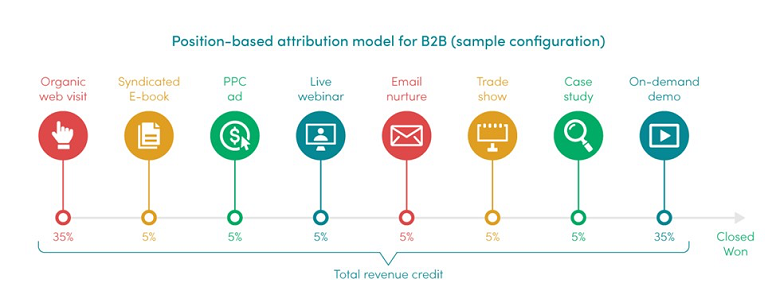
A position-based multi-touch attribution model allows you “see the forest for the trees” – to automatically connect and assign (and easily refine) the revenue and associated cost of every touch across your buyers journey, making it ideal for longer, more complex B2B buyer’s journey. With this level of insight into what’s really influencing (or not) your buyer’s journey, you can make precise decisions to continuously rebalance your marketing spend to maximize revenue.
3. Use a cohort method to determine ROI
The entire business value for building a best practice multi-touch attribution capability is based on the ability to accurately (and quickly) quantify the influence each touch has on the buyer’s decision, enabling marketers to optimize their marketing to revenue. The better the fidelity of the ROI calculation, the greater the value it has for marketers.
In senior marketer terms, a cohort method simply allows you quantify the ROI of your paid programs (ads, events, etc.) based on the start date of your ad/campaign (the initial spend) and capture the subsequent stream of conversions to calculate ROI. Having this true ROI insight allows you accurately compare “apples-to-apples” of your programs and confidently rebalance your total spend to maximize revenue. The cohort method is ideal for multi-touch attribution in longer B2B buying journeys (which makes it hugely problematic in determining true ROI), providing precise ad/campaign ROI and Customer Lifetime Value (CLTV). According to Neil Patel in The Case for Cohort Analysis and Multi-Touch Attribution Analysis, “In B2B SaaS, there are two techniques that I feel are particularly important but not used widely enough – cohort analysis and multi-touch attribution analysis.”
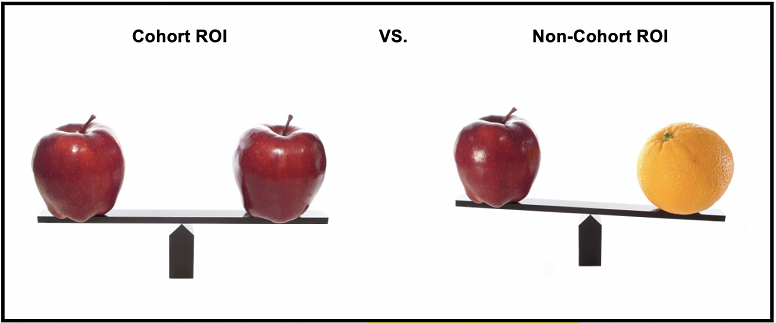
In stark contrast to the level of precision using a cohort method ROI method, a non-cohort approach typically starts with a given conversion date (i.e., content download, ad click through) and “looks back” at random and changing time periods in an attempt to quantify the true ROI, leading to poor insight about the relative performance of your programs and channels. While this method may seem straight-forward, it’s deeply misleading. As a result, when you are trying optimize your spend among Google Ads or AdRoll as an example, you are using ROI information that is analogous to comparing “apples to oranges,” leading to erroneous conclusions and suboptimal decisions.
To put in place a best practice cohort method, senior marketers should look for flexibility that allows you to calculate ROI from the campaign start date and calculate the revenue against multiple dimensions depending on your business needs such as:
- campaign/channel by source
- any date up to current
- various types of traffic
For example, you invest $10,000 each with Google Ads on January 1 and want to know how well the campaign has performed through September 30; a cohort method would automatically link conversion A for $40,000 and conversion B for $80,000 to your original investment and allocate a portion of the $120,000 revenue credit. You can then compare this to LinkedIn ads using to same method. This eliminates the fuzzy math of a using non-cohort approach and gives you true insight as to what’s really converting (and not) to make better paid spend decisions.
4. Unify offline attribution
While offline marketing such as field events and conferences generally represent a large portion of B2B budgets, their conversion outcomes are often disconnected from online marketing efforts which can lead to flawed ROI conclusions and misguided budget allocations. As an example, a common practice for offline attribution is to collect and report on outcomes shortly after the event occurred. Success is usually based on “leads captured,” “deals piped,” and/or the proverbial, “hey, that was a great conference” with 100% revenue credit allocated for any wins that were captured under a traditional first or last touch system.
But B2B buyers who visited your booth frequently visit your site (direct URL) or Google your brand, and engage in other touches (i.e., registers for a webinar, downloads an e-book). And unlike the instant conversion associated with your online channels such as clicking on a retargeting ad, offline channels have what senior marketers call the “halo effect,” meaning the true value or conversions of events shows up over a much longer period of time. How are you supposed to be able to best allocate your marketing budget when you can’t accurately determine the true ROI of offline channels and/or compare offline channels like conferences with online channels? You may be getting more revenue per dollar at conferences compared to paid ads, but you’d never know the true picture without unifying online/offline attribution.

Unifying your offline campaigns with online channels into a single multi-touch attribution system solves the attribution madness that plagues senior B2B marketers through the following capabilities:
- Automatically capture event cost and credit the stream of conversions (using a cohort method – see best practice #3) attributed to it over a longer period to account for the longer halo duration associated with offline channels.
- Flexibly assign ROI credit among offline and online with weighted touchpoints, allowing you to allocate the most accurate value of each touchpoint based on their relative impact on the whole customer journey from beginning to closed-won.
Senior B2B marketers will have a much more accurate understanding of the customer journey and marketing’s impact on it when their multi-touch attribution model takes these two capabilities into account. From branded search queries and on-demand webinar views to conference booth demos and field seminar receptions, you’ll have a single, holistic view of what’s driving conversions and revenue.
5. Track B2B account-based attribution
Today’s B2B buying journey often involves multiple people and roles – seldom will a single person click on an ad, visit your site, and purchase. B2B buyers are usually a team of people within the same account who have different buyer roles such as researcher or decision-maker depending on the buying stage. Hence, according to Martech Today, “the rise of account-based marketing has spurred a shift in how marketers think about accounts.”
Using our earlier scenario for a technology buyer for ZZZ bank who is looking for business intelligence tools, we illustrate below moving from a single buyer to multiple buyers in an account and their roles.
Best practice account-based multi-touch attribution enables you flexibly attribute the revenue and cost of all your successful marketing touches to account, resulting in complete visibility of the account-level journey and true account marketing ROI (especially account-based marketing [ABM] campaigns) and enabling you to fine tune your marketing investments to maximize revenue.
6. Make sure everything adds up
For senior B2B marketers who have ROI accountability for multiple channels and big budgets, errors adding up the right cost or assigning the correct revenue credit to touches can impair your optimization efforts and ruin your credibility among peers and board members. And with increasing complexity of the B2B buyer’s journey, current multi-touch attribution practices exacerbate this problem of duplicate and/or incorrect revenue credit.
Consider this scenario (simplified for illustrative purposes): a buyer clicks through on your LinkedIn ad and a week later he or she clicks through your Google retargeting and TechTarget content syndication offer, eventually buying your product for $50,000. And because these media programs aren’t integrated to one multi-touch attribution system, they each claim $50,000 in conversion credit. Sure you can manually override this for your presentation, but how painful is this problem with dozens and hundreds of programs running simultaneously, media prices changing constantly, and buyer journeys evolving continuously? And how would this impact your ability to demonstrate to executive and board members your ability to drive more outcomes with the same or less dollars?

To safeguard the fidelity of your attribution insights and preempt a costly and possibly embarrassing problem, senior marketers should build their attribution capability on the best B2B multi-touch attribution practices discussed earlier:
- Capture all ad and conversion data
- Connect every touch across your buyer’s journey
- Use a cohort method to determine ROI
- Unify offline attribution
- Track B2B account-based attribution
These are required to ensure you’re not duplicating attribution credit. The sixth best practice is to automatically and continuously check your calculations and allocations through multiple dimensions. In much the same way accounting is reconciling transactions, a best multi-touch attribution practice is to continuously (and proactively) reconcile revenue credit to your marketing touches. This preempts giving credit to channels/campaigns that had no role in the conversion to revenue, duplicating credit, and over/under (+/- 100%) assigning the total of all revenue credits for a given deal. In addition, you should have a complete audit trail that lets you drill down into every marketing touchpoint, channel, user, and account across your buyer’s journey.
Conclusion
According to Forrester Research’s What B2B Marketers Must Know and Do, “Crystallizing a view of the lengthy B2B purchase process and recontextualizing marketing activity as steps leading toward revenue, rather than disconnected conversions, allows B2B marketers to connect the dots along the path to won deals.” Hence, the linchpin of multi-touch attribution is the ability to precisely track and allocate credit to across all efforts that contributed to revenue. Applying these six practices to your multi-touch attribution journey will eliminate the pain of your current attribution efforts and enable you to see what’s really working (and not) so you can focus your energy on optimizing your marketing to revenue.


